Back to the Zoo
Well, it has been more than a year since I went to the Indianapolis Zoo. Some of you may remember my post last year titled Some Lighter Elements, in which a few of the Zoo's more talkative denizens really let their hair down and expressed themselves! ;) In this latest expeditionary adventure, the beasts from far afield were a bit more reticent about sharing their true feelings with me (I think they were somewhat embarrassed to have their unvarnished thoughts published last time around!), however, they were kind enough to pose for a few pictures by your intrepid host. :)
First up for your viewing pleasure is a mother elephant and her one year old baby. Interestingly, in the few weeks since my Zoo visit, another elephant gave birth! I have seen the new baby on the local TV news. She is so tiny (well, its relative) and very cute! When she was born, she weighed more than 200 pounds. Now that's quite a bouncing baby! :)

Here is a picture of the same one year old elephant with some of his keepers who were mucking out (just use your imagination, big big piles of...) the enclosure. What a good baby running over to help clean up! :)

Well, just like last year, I stopped by to see how the giraffes were doing. These two were happily munching on some food items placed in a bin up in their tree.

This may be the world's laziest rhino! When I was a kid, I was fascinated by rhinos. Many kids have a piggy bank, but I had a rhinoceros bank! Whenever I had the chance to play with clay in school, I would make a rhino. I don't remember why I liked rhinos so much, maybe I just thought their horns looked cool.
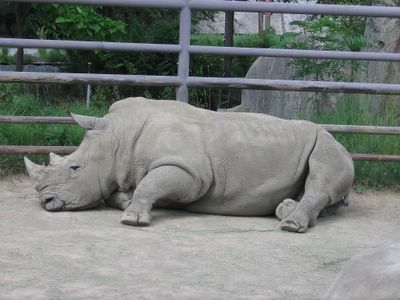
Here are some cute little guys called meerkats, who hale from Africa's Kalahari Desert. They are a relatively new exhibit at the Zoo. They are housed in a very neat building with a geodesic glass dome. Inside the building are all sorts of creatures that inhabit various desert environments around the world like lizards, tortoises (I took a few reptile pics, but they weren't that exciting), and various birds. There are actually about a dozen meerkats in the exhibit. They are very social animals that live in large family units. They are somewhat similar to prairie dogs (large ground squirrels from the American West) in their habit of digging large underground homes. They seem so intelligent when they look right at you with their big eyes, and boy are they curious! If all humans, apes, and monkeys were to somehow vanish from the face of the Earth (not an impossibility, in my opinion, I am sorry to say), I can really see meerkats taking over after a few million years! If you get the cable channel Animal Planet, there is a fun and interesting show called Meerkat Manor which follows the lives of a large family group. It is rather like an animal soap opera! :)
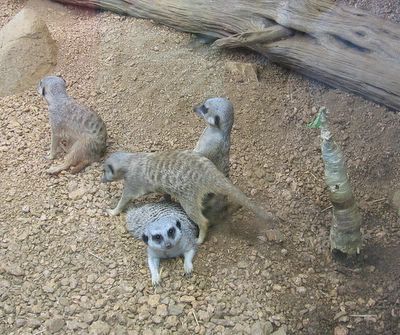
Here are some really colorful and quite tame parrots. They were just about eating out of people's hands, as you can see! Parrots are probably the smartest of all birds. I saw a program about an African Gray Parrot that has learned about 300 words and can apparently speak in complete sentences! As I recall, his trainer is a research psychologist. Her work is really opening up a new frontier in the understanding of intelligence! Maybe I was a bit hasty in predicting that meerkats will inherit the Earth. ;)

Ah, now this may well be one of the best photographs that I have ever taken! Just as I did last year, I also stopped by the Indianapolis Botanic Gardens, which is next to the Zoo. Every year, they have an indoor butterfly exhibit for several months. This butterfly is a member of a group called blue morphos. They live in Central and South America. This is a very large butterfly, having a wing span of about six inches. It flitted right past my face, actually startling me! Then it landed on a nearby hanging basket of ferns. I just walked up, lifted my digital camera above my head, and snapped a few quick pics. This one was the best. Usually, when these particular butterflies land, they fold their wings up so that only the underside of the wings are visible. The undersides are a rather drab brown with small eye spots. I think they are colored to resemble dead leaves to help the butterfly hide in trees. However, for some reason, this butterfly decided to show its upper wings in their full iridescent glory!

The next two pictures were not taken at the Zoo or the Gardens, but rather near where I live. The subject of the photos is probably the most famous of North American butterflies, the Monarch. These butterflies are best known for their epic migration (some fly more than 2000 miles!) which occurs every year in the Fall. All the Monarch butterflies, from as far north as parts of Canada, south to Florida, and west to California, migrate to a few isolated places in the mountains of central Mexico (some over winter in California: see update below). There, as many as half a billion Monarchs will spend the winter, alive but in a semi-torpid state, occasionally rousing from their rest to flit about. The trees are literally carpeted with butterflies! Unfortunately, in recent years, these mountain sanctuaries have come under attack by logging pirates who have been illegally cutting the trees. Hopefully, these places will be better protected in the future! When the warming of Spring comes, the Monarchs once again start to fly northward. Throughout the Spring and Summer months, there may be as many as five generations of Monarchs that spread out north, east, and west, until they reach the limits of the continental U.S. and southern Canada. Then, once again, the cycle repeats when the last generation of the year instinctively knows to fly all the way back to Mexico. The Monarch is one of the true wonders of nature! This particular one is apparently stocking up on nectar to fuel the next leg of its long journey.
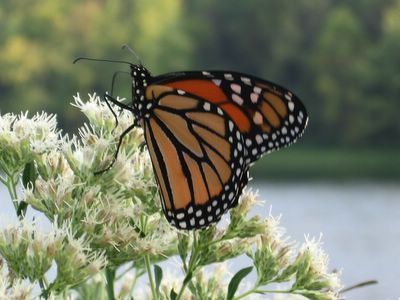
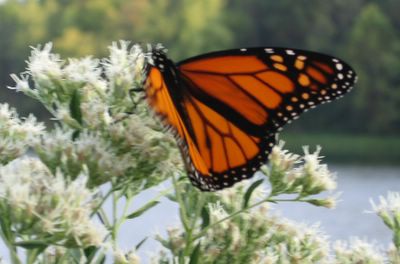
Here is a link to a wonderful site showing pictures of the Monarch butterfly's complete lifecycle from egg, caterpillar, chrysalis (the fascinating metamorphic stage between caterpillar and butterfly), and adult. These are really terrific pictures, so please check them out! If you would like to learn more about the Monarch migration and the threats to their conservation in Mexico, this news article from a few years ago is very informative.
Monarch Update: My friend Jarvenpa has just taught me that Monarch butterflies also have winter homes in California. Here is a link to the State Park at Santa Cruz, CA where some of the Monarchs spend the winter. Apparently, The Monarchs west of the Rocky Mountains spend the winter in California, while those east of the Rockies fly to Mexico. I found a Wikipedia article that taught me even more about Monarchs. This article said that Monarchs live in Bermuda, Spain, and Portugal, and are sometimes seen in England. Also, they were introduced to Australia and New Zealand in the 1800's. Thanks Jarvenpa!
Finally, a 15 year old blogger from Rasht, Iran commented recently to my previous post. He is apparently a very accomplished journalist, and I was impressed with his blog. So, if you would like to give this young man some encouragement, why don't you check out Kourosh's blog. He surprised me by saying that my blog is being filtered in Iran. Well, I guess that I have finally "arrived"! ;)
First up for your viewing pleasure is a mother elephant and her one year old baby. Interestingly, in the few weeks since my Zoo visit, another elephant gave birth! I have seen the new baby on the local TV news. She is so tiny (well, its relative) and very cute! When she was born, she weighed more than 200 pounds. Now that's quite a bouncing baby! :)

Here is a picture of the same one year old elephant with some of his keepers who were mucking out (just use your imagination, big big piles of...) the enclosure. What a good baby running over to help clean up! :)

Well, just like last year, I stopped by to see how the giraffes were doing. These two were happily munching on some food items placed in a bin up in their tree.

This may be the world's laziest rhino! When I was a kid, I was fascinated by rhinos. Many kids have a piggy bank, but I had a rhinoceros bank! Whenever I had the chance to play with clay in school, I would make a rhino. I don't remember why I liked rhinos so much, maybe I just thought their horns looked cool.

Here are some cute little guys called meerkats, who hale from Africa's Kalahari Desert. They are a relatively new exhibit at the Zoo. They are housed in a very neat building with a geodesic glass dome. Inside the building are all sorts of creatures that inhabit various desert environments around the world like lizards, tortoises (I took a few reptile pics, but they weren't that exciting), and various birds. There are actually about a dozen meerkats in the exhibit. They are very social animals that live in large family units. They are somewhat similar to prairie dogs (large ground squirrels from the American West) in their habit of digging large underground homes. They seem so intelligent when they look right at you with their big eyes, and boy are they curious! If all humans, apes, and monkeys were to somehow vanish from the face of the Earth (not an impossibility, in my opinion, I am sorry to say), I can really see meerkats taking over after a few million years! If you get the cable channel Animal Planet, there is a fun and interesting show called Meerkat Manor which follows the lives of a large family group. It is rather like an animal soap opera! :)

Here are some really colorful and quite tame parrots. They were just about eating out of people's hands, as you can see! Parrots are probably the smartest of all birds. I saw a program about an African Gray Parrot that has learned about 300 words and can apparently speak in complete sentences! As I recall, his trainer is a research psychologist. Her work is really opening up a new frontier in the understanding of intelligence! Maybe I was a bit hasty in predicting that meerkats will inherit the Earth. ;)

Ah, now this may well be one of the best photographs that I have ever taken! Just as I did last year, I also stopped by the Indianapolis Botanic Gardens, which is next to the Zoo. Every year, they have an indoor butterfly exhibit for several months. This butterfly is a member of a group called blue morphos. They live in Central and South America. This is a very large butterfly, having a wing span of about six inches. It flitted right past my face, actually startling me! Then it landed on a nearby hanging basket of ferns. I just walked up, lifted my digital camera above my head, and snapped a few quick pics. This one was the best. Usually, when these particular butterflies land, they fold their wings up so that only the underside of the wings are visible. The undersides are a rather drab brown with small eye spots. I think they are colored to resemble dead leaves to help the butterfly hide in trees. However, for some reason, this butterfly decided to show its upper wings in their full iridescent glory!

The next two pictures were not taken at the Zoo or the Gardens, but rather near where I live. The subject of the photos is probably the most famous of North American butterflies, the Monarch. These butterflies are best known for their epic migration (some fly more than 2000 miles!) which occurs every year in the Fall. All the Monarch butterflies, from as far north as parts of Canada, south to Florida, and west to California, migrate to a few isolated places in the mountains of central Mexico (some over winter in California: see update below). There, as many as half a billion Monarchs will spend the winter, alive but in a semi-torpid state, occasionally rousing from their rest to flit about. The trees are literally carpeted with butterflies! Unfortunately, in recent years, these mountain sanctuaries have come under attack by logging pirates who have been illegally cutting the trees. Hopefully, these places will be better protected in the future! When the warming of Spring comes, the Monarchs once again start to fly northward. Throughout the Spring and Summer months, there may be as many as five generations of Monarchs that spread out north, east, and west, until they reach the limits of the continental U.S. and southern Canada. Then, once again, the cycle repeats when the last generation of the year instinctively knows to fly all the way back to Mexico. The Monarch is one of the true wonders of nature! This particular one is apparently stocking up on nectar to fuel the next leg of its long journey.


Here is a link to a wonderful site showing pictures of the Monarch butterfly's complete lifecycle from egg, caterpillar, chrysalis (the fascinating metamorphic stage between caterpillar and butterfly), and adult. These are really terrific pictures, so please check them out! If you would like to learn more about the Monarch migration and the threats to their conservation in Mexico, this news article from a few years ago is very informative.
Monarch Update: My friend Jarvenpa has just taught me that Monarch butterflies also have winter homes in California. Here is a link to the State Park at Santa Cruz, CA where some of the Monarchs spend the winter. Apparently, The Monarchs west of the Rocky Mountains spend the winter in California, while those east of the Rockies fly to Mexico. I found a Wikipedia article that taught me even more about Monarchs. This article said that Monarchs live in Bermuda, Spain, and Portugal, and are sometimes seen in England. Also, they were introduced to Australia and New Zealand in the 1800's. Thanks Jarvenpa!
Finally, a 15 year old blogger from Rasht, Iran commented recently to my previous post. He is apparently a very accomplished journalist, and I was impressed with his blog. So, if you would like to give this young man some encouragement, why don't you check out Kourosh's blog. He surprised me by saying that my blog is being filtered in Iran. Well, I guess that I have finally "arrived"! ;)
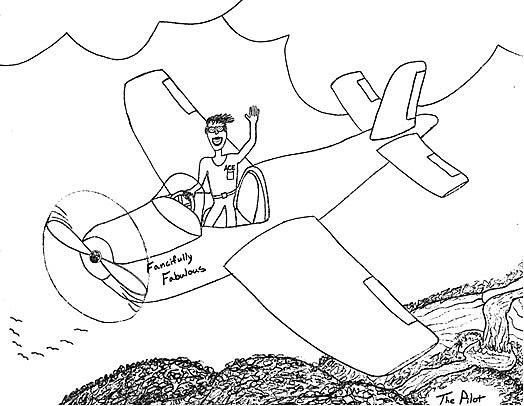

13 Comments:
Yes David, I had seen your earlier entry. I didn't have much to say about the discussion. But these animals are cool, and your pictures are great (what camera do you use?). I love animals and actually can spend hours in the Zoo, particularly in the primates section (don't ask!).
Hi Khodadad,
What? No comment about the most profound "emasculation" in all of art history?! Well, thats ok. Although it may be hard for you to believe, I don't comment on every post that I read either. ;)
I'm glad you enjoyed my pictures! :) I like primates too. The Indianapolis Zoo has baboons and some smaller monkeys, but no great apes. Considering how intelligent chimps, gorillas, and orangutans are, it is really a shame to see how they are kept in captivity in some places. However, a few zoos are doing a pretty good job. For example, the zoo in Atlanta, GA has large outdoor enclosures where the gorillas are kept in family units, which is as close to natural conditions as any zoo has come to my knowledge.
My camera is actually a fairly basic model (although, I don't know what 75% of the buttons and dials do yet!). It is a Canon PowerShot A510 with 3.2 Mega Pixels. I bought it last year on deep discount. Newer versions of this camera are available with about 5 Mega Pixels now. It has a zoom feature that I really like (4X optical zoom) that lets me frame my subjects quite well. The camera came with a 16 MB memory card, which I quickly found a bit confining. So, I bought a 256 MB memory card. It is far bigger than I need, but the price was right. Its amazing to me that you can now buy 2 GB memory cards that are about the size of a postage stamp. It wasn't all that long ago when that much storage capacity occupied a very large room!
Oh, cool photos. The Monarchs end up on my coast (though further south, mostly--some of them stray up here). I once saw the trees where they rest near Santa Cruz...very tall eucalyptus trees covered with thousands of butterflies. It was very beautiful.
My daughter is fond of meercats (I hear there is a show on one of the nature channels that is kind of a meercat soap opera).
Jarvenpa, you have just taught me something about Monarchs that I did not know! I never knew that some Monarchs spent the winter in California. I looked at the web site for the State Park in Santa Cruz and I found a Wikipedia article on Monarchs that talked about their California winter home, as well. In fact, that article said that Monarchs live in Bermuda, Spain, and Portugal, and are sometimes seen in England. Also, they were introduced to Australia and New Zealand in the 1800's. I have added an update to the post to include this additional information. Thanks for making me do some extra homework! :)
I have seen that Meerkat show. It is called Meerkat Manor on Animal Planet. I placed a link to the show in the post. Thanks for reminding me of this.
Great photos, David!
So you're an Indie resident? I visited your hometown for just a day and a half in June... and I was quite impressed with the Soldiers' and Sailors' Monument -- it reminded me so much of the Iranian "meidoons"... like Ferdowsi, for some reason....
Anyway... thought you might be interested to know:
In the late 1950's, the Rhinoceros became the symbol for an artistic and intellectual movement that viewed any position not Existential as absurd. In his play, "Rhinoceros," ( Paris, 1960) Eugene Ionesco wrote of a village whose inhabitants, absorbed by ideologies, turn into rhinoceroses one after another. Stubborn and blindly charging, their hides are so thick that any stone would just bounce right off.
The animal continues to stand for satire and absurdity, but the connotation today is not a critical or serious one, but fun-loving.
And also this:
In Khaggavisāna-sutta (Pali for, "The Rhinoceros Sutra") the Buddha says one should wander lonely as a rhino, but the verse also suggests that a non-violent disposition and an intentional lack of desire for companionship are qualities of this animal:
Renouncing violence for all living beings,
harming not even a one;
You would not wish for offspring,
so how a companion?
Wander alone like a rhinoceros.
I have always had this scarey feeling abt friendly elephants! I feel their strength all too well!
I had a Girraff bank. The coins enterd from the head & there was a valve in the neck which prevented the coins to roll back (grrrrr...) but I guess I learnt that when I broke it's neck to finally empty that filthy money-loving bastard!! I was always jealous of their long necks.
Rhinos hmmm... my only memory is the hard spelling!! Why does the word have to be so hard to spell???
Thanks Tamara! :)
I have seen the monuments in the center of Indianapolis and I agree they are quite impressive. The tallest of the monuments is dedicated to Civil War and WWI veterans. It has a very interesting museum beneath it that is full of Civil War related items. I was most taken with the many tiny photographs of Civil War Soldiers.
I did not know that rhinos had such religious and philosophical importance! Perhaps my childhood interest has Karmic implications! ;) Well, I have never claimed to be an expert on philosophical theories, so I had to look up existentialism to see what it was all about. I found this quote in a Wikipedia article: "Existentialism tends to view human beings as subjects in an indifferent, objective, often ambiguous, and "absurd" universe in which meaning is not provided by the natural order, but rather can be created, however provisionally and unstably, by human beings' actions and interpretations." I think that I may be an existentialist! :) As for the Buddha's wise sayings, I'm all for renouncing violence (however, I am still partially carnivorous, which is potentially conundrumous ;) ), but I have no desire to "wander alone like a rhinocerous."
Omid, I have actually touched an elephant several times! Their skin is very thick and rough with lots of small coarse hairs. They are very strong indeed, but if they are well treated, they almost never harm anyone. They are so smart and have such remarkable memories! I think they are amazing creatures. One of the elephants at the zoo actually paints pictures on canvas, which the zoo sells to raise a little money. She holds the brush in her trunk and chooses her own colors. I have seen several of her works of art and I found them to be quite interesting!
You had a bank that you couldn't get your money out of?! Who would give a child such a present? I think giraffe necks are pretty neat too. I am a bit surprised that they didn't evolve a very thick and long tail to balance the long necks, sort of like a later day brontosaurous. :)
Hi Madas, I am happy to see you here! :) You saw a life size giraffe toy? That must have been one amazing toy store! Was it like a Trojan Giraffe that kids could climb up into and plan their next conquest? That sounds kind of Monty Pythonesque (I think they did a giant bunny)! ;)
HI David.I like your post and the p ohotos are so nice ,we don't have a zoo in mosul right now ,
I posted anew post
i hope you visit my blog
maas
I have a "thing" about elephants. I've loved them ever since I was a small kid. But a couple of years ago, R and I went to a circus. Sitting in front row, we almost had a "accident", which could have ended up very messy with elephant shit all over the lap... thankfully it missed. At that time I realised how big they really are, and nowadays I only dream about meeting a baby-elephant.
:-)
(great photos David, do you mind if I borrow some of them for my swedish blog - I promise to state copyright)
Maas, it is great to hear from you! :) I have been wondering how you have been doing all these months. I am glad you enjoyed my pictures and I will certainly visit you!
Nyx, I am glad for you that you weren't buried by the "accident"! ;) As I said to our friend the Doctor, I actually touched an elephant recently, and she was quite large! The top of her shoulder was at least ten feet high.
You are welcome to share my pictures in your blog. Don't worry too much about copyright, just mention your friend David took them. :)
Post a Comment
<< Home